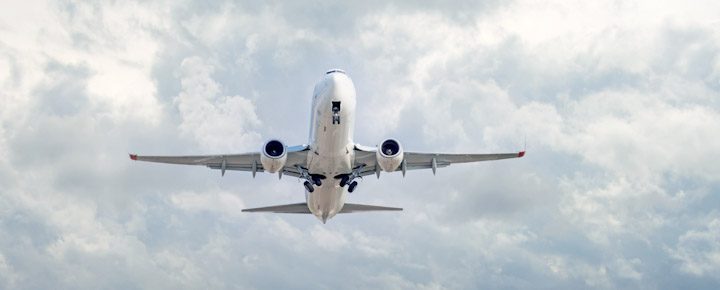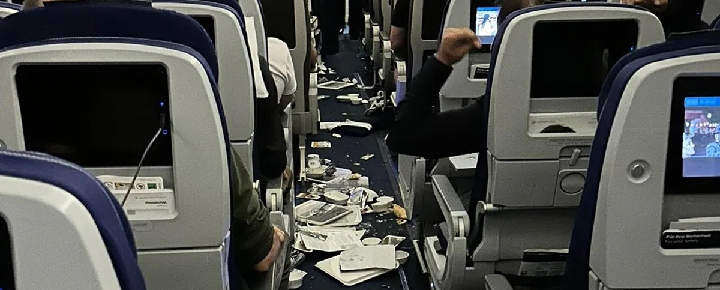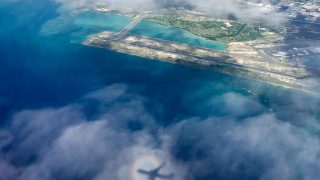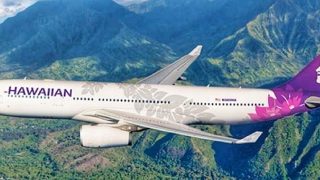Following the recent Hawaiian Airlines mass casualty incident, turbulence remains in our minds and apparently everyone else’s. Flight 35 encountered extreme clear-air turbulence on December 18 as it was nearing Honolulu. Three dozen were injured, 20 went to the hospital, and 11 were seriously injured following turbulence and an altitude drop severe enough to send passengers smashing into the overhead compartments and ceiling. In one of the videos from the event, the flight crew pleaded for trained medical or firefighters to step forward to help.
Just before its descent, about one-half hour from landing, in clear weather and with nothing on radar (but with severe nearby storms), the pilot reported a vertical cloud shot up out of nowhere directly in front of him so quickly that he was unable to get around it.
The NTSB report said the cloud (which occurred in otherwise clear air) caused that unusually forceful turbulence, causing a drop in altitude, injuring passengers and crew, and even causing aircraft damage.
Controversy followed this Association of Flight Attendants statement.
Recently CBS published an article quoting the Association of Flight Attendants saying that airline turbulence will become more common, perhaps due to climate change.
Severe weather increases chances of turbulence, and due to climate change, these kinds of incidents will only continue to grow. — Tahlor Garland, AFA.
Others claimed the story was balderdash, and pushback included that the flight attendants’ union shouldn’t comment on climate change and that they should further be ashamed of themselves. Some naysayers conclude there isn’t data to support climate change in the first place and that those doing so are a part of a get-rich scheme associated with some political narrative.
Some studies have indicated at least the potential for a relationship between changing atmospheric conditions and clear air turbulence. Undoubtedly that is something we’ll be learning much more about going forward.
And while technology arguably makes turbulence easier to predict and plan for (try telling Hawaiian Airlines and their passengers that!), that sure hasn’t prevented or explained some terrible incidents like the one that just happened.
Shocking Hawaiian Airlines turbulence video. Warning: video contains disturbing images.
pic.twitter.com/PGR3RO5ZMl— World Latin Honey (@WorldLatinHoney) December 21, 2022
Another clear air turbulence incident injured 37, resulting in a Hawaii flight diversion.
In 2019, more than three dozen passengers and flight crew were injured when an Air Canada 777 widebody hit extreme clear air turbulence about two hours southwest of Hawaii. The flight from Vancouver to Sydney diverted to Honolulu, and thirty people were taken to local hospitals.
Should you worry about Hawaii flight turbulence?


The FAA defines turbulence as “air movement created by atmospheric pressure, jet streams, the air around mountains, cold or warm weather fronts or thunderstorms.” It can be unexpected and happen when the sky appears clear. Turbulence can give an airplane a sudden jolt, injuring passengers and crewmembers who aren’t buckled in.
According to FAA-reported data, at least, getting seriously injured in turbulence is quite rare. In the 13 years ending 2021, there were 146 severe injuries due to airline turbulence. That comes out to 11 passengers a year.
What can passengers do to avoid injuries caused by air turbulence?
The FAA says, “Passengers can easily prevent injuries from unexpected turbulence by keeping their seat belt buckled at all times. The FAA’s tips for staying safe:
- “Listen to the pilots and flight attendants — FAA regulations require passengers to be seated with their seat belts fastened whenever the seat belt sign is illuminated during flight.
- Pay attention to the safety briefing at the beginning of your flight and read the safety briefing card.
- Use an approved child safety seat or device if your child is under two.
- Prevent inflight injuries by adhering to your airline’s carry-on restrictions.”
The FAA is actively working to prevent turbulence injuries.
The FAA developed specific guidelines for the airlines to help avoid risks due to turbulence when airliners encounter it. That is based on work by the NTSB. The FAA also has several programs to help reduce airline turbulence injuries. Those include:
- Improved data collection and sharing.
- Modernizing the Pilot Report System (PIREPS), where pilots communicate weather conditions, including turbulence.
- Improving automation to enable pilots and air traffic controllers to digitally enter and share reports rather than having to do so verbally.
- Encouraging pilots to file more reports.
- Using more data in dispatching.
- Training for air traffic controllers about the importance of soliciting and disseminating PIREPs.
- Using automation and data displays to route aircraft around weather systems.
- Promoting real-time information sharing between pilot and dispatcher and including turbulence in weather briefings.
Passengers can easily prevent injuries by following FAA guidelines, including keeping seat belts buckled at all times. And FAA regulations require passengers to be seated with their seat belts fastened:
- When the airplane leaves the gate and as it climbs after takeoff.
- During landing and taxi.
- Whenever the seat belt sign is illuminated during flight.
On a nicer note: In-flight turbulence and a great flight attendant go viral.


The Delta flight attendant above, comforting a frightened passenger during turbulence, went viral after CNN picked it up. That speaks to the level of concern turbulence causes. Delta’s Floyd Dean-Shannon helped the passenger on the mainland flight get through it and is seen holding her hand. Way to go!
The flight attendant who just started in the position three months ago is quoted as saying, “Hey, I have you,” while seated in the aisle next to her. Dean-Shannon told CNN the passenger said, “I don’t want this; I’m embarrassed.” And he replied, “there’s no need to be embarrassed; I’m here.”
Floyd was quoted on Delta’s website: “As a flight attendant, you set the tone. As a passenger, I would want to be treated the same way. I have to remember; I was in that seat, too… When she came onto the plane, she was a little nervous… Before we even took off, she started sweating.”
Seasoned pilot Dave Wallsworth discusses airliner turbulence.
Dave was recently asked questions on his popular Twitter feed about turbulence and how to plan for it. One of the questions asked was how passengers could know if turbulence would be bad. When do you consider turbulence bad? Are you in contact with those around you to see how their ride is going?
Dave: Bad to me is when we have to get passengers to sit down and fasten their belts. Really bad is when we have to get the crew to do the same. We will always do our best to minimize the time in bad turbulence, and yes, we get reports from other aircraft around us. I prefer to be honest with people and say if I think it’s going to be a little bumpy at times so people aren’t surprised and also know we are expecting it. Turbulence really isn’t a problem… I’m always more concerned about the well-being of the passengers and crew rather than being worried about the aircraft. It will be fine.”
— Captain Dave (@DaveWallsworth) January 24, 2023
Dave is a highly regarded, 30-year veteran wide-body pilot. BOH editors Rob and Jeff had the opportunity to fly with Dave on an A380 British Airways flight he piloted from London to Johannesburg. As an aside, that was pretty amazing for lifelong fliers and aviation buffs such as them. For those who might want to see what one of Dave’s flights looks like from his cockpit view, we’ve got that video too.
Have you experienced extreme turbulence on a flight?
Get Breaking Hawaii Travel News






I, as well as many people, have been through bouts of turbulence while flying without being injured. I’ve been stuck on the toilet 2 times and managed to be safe, 1 of those times I was lifted off of the toilet seat but grabbed the walls to avoid problems. Too many times people disregard the seat belt sign and request and wonder why they have mostly minor aches and pains afterwards. Practically every flight just prior to landing some must retrieve their bags from the overhead so as to make a quicker departure, they should be warned and then Banned. Certain people cannot help themselves but will Sue for their bumps, bruises and worse. Can’t follow orders, no sympathy here!
I flew out going west to NJ several hours after the HAL flight arrived. The crew had to strap in a least 2 times during the flight (it was a 10 hour red eye). My experience is that the Pacific is always somewhat turbulent.
Awesome Captain Dave video LHR-JNB A380. Thank you for posting
Hi Evan.
Thanks. And that wasn’t half as fun as flying with him as the pilot.
Aloha.
NWS said that the statement saying more turbulence is expected due to global warming has no basis in fact.
Global warming is important on its own. This was a poor attempt at correlation.
I’ve held a pilots license for 44 plus years, OMG that’s like a long time, turbulence is no different today then when I got my license in 1979.
What I found in the article is anytime someone can connect climate change to an event, like the Hawaiian turbulence event” means they’ve figured out away to secure a government grant to study it.
It’s all about the money.
I experienced clear air turbulence on a Singapore Airlines flight many years ago. It was just after meal service (they offered a meal, so you know it was a long time ago), and plates and cutlery went flying. Fortunately no one was injured, but it was scary even though it didn’t last long. I always stay buckled up in flight, as does my pilot husband.
Aloha Guys! Mahalo once again for another informative article. Yes, I have experienced bad turbulence a couple of times. Once was on a flight from Burbank to Oakland on Southwest (this was back in the day when SW was still handing out peanuts.) Anyway, the flight was getting bumpy, and the pilot announced “We are experiencing some heavy turbulence, so the plane will be tossing you your peanuts instead of the crew. And we sincerely hope that it doesn’t cause you to toss your peanuts during this time.” I really appreciated him using humor to diffuse the tension.
This should not be a big problem as far as protecting yourself from injury. Perhaps it’s because we fly so often, but I am very consistent about keeping my seat belt fastened loosely at all times. It is not uncomfortable and could save you a very uncomfortable injury. No I only have to worry about flying beverage carts. Lol.
Aloha
Hi BOH . Mahalo for another thoughtful article.
My family returned to PDX from Vegas on a red eye one time with such strong turbulence that the cabin crew quickly returned to their seats and buckled in where they then remained the entire flight. I kept saying to myself “The plane was built for this and the flight crew knows what they’re doing. We are safe”. It helped a lot to have a little mantra. My kids slept through the entire thing! Also Vegas to PDX= short flight!
Aloha!
See Furtado vs hawaiian air, us dist Court hawaii.
Furuta
I saw the court filing that you are referencing. What is the point that you are trying make by bringing up this case? You understand that Hawaiian Airlines is not the only has ever encountered turbulence resulting in passenger and crew member injury.
My wife who was a Flight Attendant on the flight I was on was badly injured when a Turbulence happened, I saw her from standing and thrown up to the ceiling of the Airplane, and fell and landed on the floor, people should realize no one knows when a Turbulence will happen so from I saw, I always keep that seat belt on me, even if that seatbelt sign is off, the best advise I’m giving everyone, it will happen. (Don’t think it won’t)
I think it is important to distinguish between the different types of
Turbulence to stop people worrying.
1. Chop is when you are bounced around. Caused by two airmasses joining. Unpleasant, will throw things about, will cause people not used to bracing for it to fall and can open overhead bins if not properly latched. No need to worry over this.
2. CAT or Wind-shear. This where the plane changes height very rapidly caused by wind masses with severe differences. Seated fully belted, you need to watch out for items in the cabin.
There is a reason why the flight deck wear their belts. CAT and wind-shear are much more difficult to detect. The only time to get worried about shear is on approach or take off.
Your first sentence describes a mass casualty event. I read that and thought “OMG, people died? And how many?” After reading further, there weren’t any deaths in this incident, thank God. You may wanna rephrase that first sentence.
“Casualty” means killed OR injured, so it’s actually used appropriately here. I actually just learned this three days ago when helping my kid study for a test in an AP history class. The textbook had different stats than a government website I was looking at about a particular Civil War battle, or so I thought. But it turned out one mentioned number of casualties (which I assumed meant deaths) and the other mentioned number killed. And my high school student had to explain the difference to me.
Honestly the whole thing comes down to accountability. No one likes to see people injured or airlines having issues but people need to listen and follow the rules!!! Yeah you! I’ve never been on a fight in my 50 years of flying where I wasn’t reminded to wear my seat belt when ever I was seated. Whether the fasten seat belt sign was on or not. It’s simple… if these folks would have done what they are supposed to do injuries probably would have been minimal.